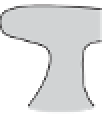Geology Reference
In-Depth Information
Beach-profile shape adjusts swiftly to changes in the wave
'climate'.
Beach cusps and crescentic bars
Viewed from the air, beaches possess several distinctive
curved plan-forms that show a series of regularly spaced
secondary curved features (Figure 13.8). The primary
and secondary features range in size from metres to more
than 100 km.
Beach cusps
are crescent-shaped scallops
lying parallel to the shore on the upper beach face and
along the seaward margins of the berm with a spacing
of less than about 25 m. Most researchers believe that
( ) Rhythmic topography on inner bar
a
Rip
current
Bar
crest
Figure 13.7
Terminology used to describe (a) wave and
current processes in the nearshore, and (b) the beach
profile.
Source:
Adapted from Komar (1998, 46)
()Crescentic bars
b
Beach profiles all consist of a series of ridges and troughs,
the two extreme forms being steep, storm profiles and
shallow, swell profiles, with all grades in between. The
most inland point of the beach, especially a storm beach,
is the
berm
, which marks the landward limit of wave
swash. Over the berm crest lies the
beach face
, the
gradient of which is largely controlled by the size of
beach sediment. Fine sand beaches slope at about 2
◦
,
and coarse pebble beaches slope at as much as 20
◦
, the
difference being accounted for by the high permeabil-
ity of pebbly sediment, which discourages backwash.
On shallow-gradient beaches, a submerged
longshore
bar
often sits offshore, separated from the beach by a
trough
. Offshore bars, which are more common on swell
beaches, seem to result from the action of breaking waves
and migrate to and from the shoreline in response to
changing wave characteristics. Similarly, the beach profile
changes as wave properties run through an annual cycle.
Tr ough
Giant cusp
or sand wave
()Combination
c
c
resc
Inner
bars
Figure 13.8
Cusps and crescentic bars.
Source:
Adapted from Komar (1998, 475)








































































































































